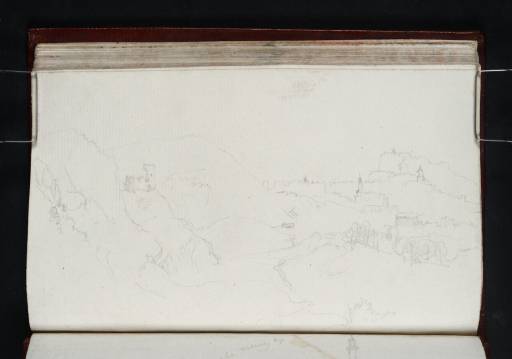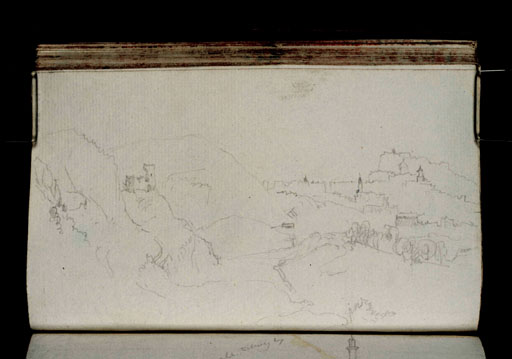Joseph Mallord William Turner Edinburgh, from Arthur's Seat 1818
Image 1 of 2
Joseph Mallord William Turner,
Edinburgh, from Arthur's Seat
1818
Joseph Mallord William Turner 1775–1851
Folio 58 Verso:
Edinburgh, from Arthur’s Seat 1818
D13424
Turner Bequest CLXV 56a
Turner Bequest CLXV 56a
Pencil on white laid paper, 99 x 159 mm
Accepted by the nation as part of the Turner Bequest 1856
References
1909
A.J. Finberg, A Complete Inventory of the Drawings of the Turner Bequest, London 1909, vol.I, p.480, CLXV 56a, as ‘Edinburgh, from Arthur’s Seat.’.
Drawn with the sketchbook inverted, this view shows Edinburgh from a similar position as the preceding drawing in the sketchbook (folio 57 verso; D13422; CLXV 55a). We stand on Arthur’s Seat, which takes up above half of the page, looking down the hill with St Anthony’s Chapel on our left, and the city with Edinburgh Castle high above on the right. The spires and towers in the drawings are probable the Tron Kirk on the left, the large open crown spire of St Giles’s Cathedral below the castle, Heriot’s Hospital to its left, and perhaps St Mary’s at the far left. A similar view is drawn on folio 59 verso (D13426; CLXVII 57a).
Edinburgh from St Anthony’s Chapel was a subject illustrated for the second number of the Provincial Antiquities in August 1819 by A.W. Callcott, and engraved by George Cooke. Scott described the chapel as ‘a shattered ruin [that] rises on the shoulder of Arthur’s Seat’,1 and Turner’s sketch, like Callcott’s design, demonstrates this by drawing the ruin with a broken outline echoing the serrated line of the hillside.
Turner had sketched St Anthony’s Chapel in the Edinburgh, 1818 sketchbook of 1801 (Tate D02816, D02817, D02818, D02819; Turner Bequest LV 4a–6), and he returned to the subjects of Arthur’s Seat and St Anthony’s Chapel in 1822 (King’s Visit to Scotland, Tate D17573, D17574; CC 40a, 41). His interest in the subject was therefore a sustained one that preceded the Provincial Antiquities project and continued after it. His reason for drawing the subject on this occasion may therefore have been unrelated to any specific commission, he was simply attracted to a subject that combined manmade ‘antiquities’ and natural ‘picturesque scenery’, with both ancient and contemporary architecture in view.
Thomas Ardill
November 2007
How to cite
Thomas Ardill, ‘Edinburgh, from Arthur’s Seat 1818 by Joseph Mallord William Turner’, catalogue entry, November 2007, in David Blayney Brown (ed.), J.M.W. Turner: Sketchbooks, Drawings and Watercolours, Tate Research Publication, December 2012, https://www


